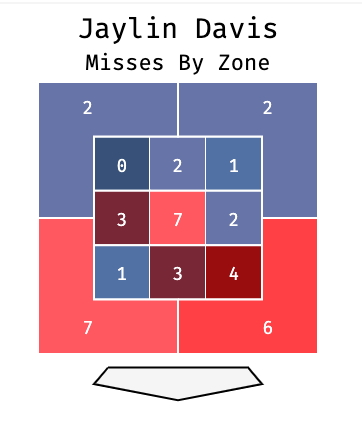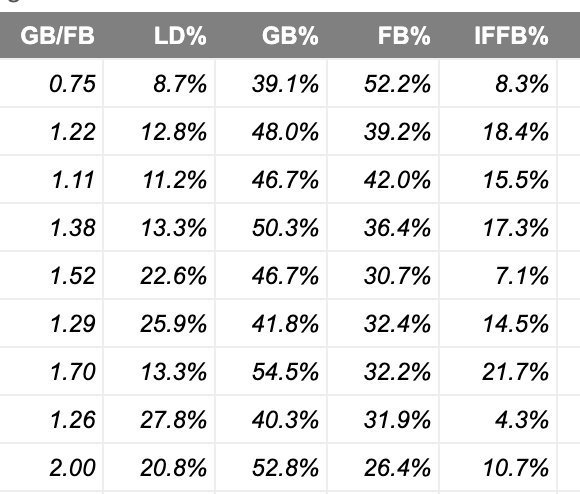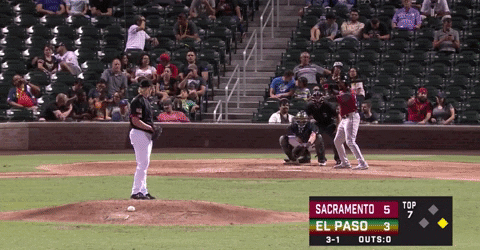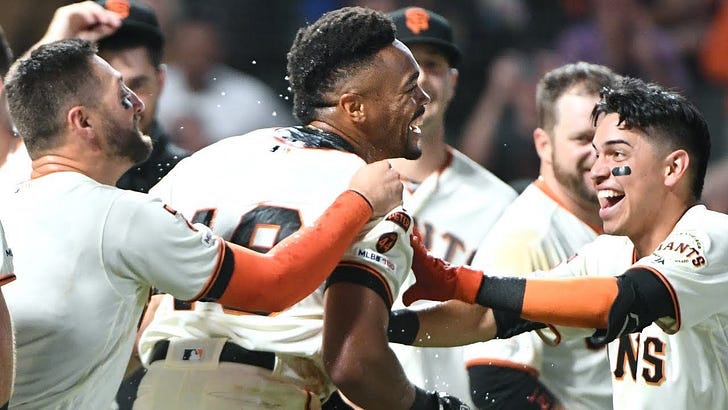You know, by now, that I’m not really comfortable with declarative sentences — next week I’ll no doubt be bringing you “The most important Giant(s) in 2020: The 25-part Series.” But I don’t feel like I’m climbing out on a limb when I say that much of The Farhan Experiment/2020 (or whenever) rides on the development of one of the most intriguing acquisitions of 2019: OF Jaylin Davis.
That would be this happy guy — you remember:
Davis has been the subject of much discussion this spring, and making sure there is opportunity for him to prove himself — to “give him a long runway” in Zaidi’s terms — appears to have impacted the team’s acquisition philosophy this winter and even to this very day (as Yasiel Puig sits by his phone).
While the organization works to rebuild the talent in the farm system, that avenue for returning the big league club to its winning ways is still likely several years away from bearing fruit (Jim Callis on our recent podcast guessed that 2023 might be the turning of the tide as far as help from the system goes). Preventing the club from suffering through the longest stretch of losing seasons in the franchise’s 140 year history then, will require some big results from major league assets. To continue the seemingly obligatory Dodgers metaphor, we’ll need some Chris Taylors and Max Muncys. We saw one of those minor transactions pay off in a big way in 2019 when Mike Yastrzemski posted a 121 wRC+ and a 2 Win season in just 107 games. But little Yaz turns 30 next month which makes him maybe not a perfect fit for “the next good Giants team.” (Though baseball is a surprising sport — stay hot, Mike!)
And thus, much focus centers on the now-26 year old OF (his birthday was last week) acquired as part of the Sam Dyson deal with the Twins. Both Manager Gabe Kapler and GM Scott Harris have been asked about Davis in the past week, and it seems clear that one of the measures of “success” for the Giants in 2020 will be Davis asserting his presence as a legitimate major league OF and potential impact bat.
Just to give the thumbnail bio once again: Davis was an intriguing power-speed player at Appalachian State (playing under Ryder Jones’ father). He caught some scouts’ eyes when he took NC State’s (now White Sox) Carlos Rodon deep two different times. But entering his Junior year he injured his non-throwing shoulder making a diving catch and that caused him the entire 2015 season (college and pro). Minnesota took a flyer on him with a 24th round pick, an upside value play on his athleticism and power.
His progress in pro ball, however, was slow for a college player. Over his first three full seasons Davis hit just 42 home runs in 309 games, and slugged just over .400 in almost 240 games in A ball. But after working with Twins coaches to incorporate his lower half into his swing better using a leg-kick to generate power. They also worked to steady his head so that he tracked pitches better. With the changes, Davis exploded in 2019, hitting 35 HRs across two levels and posting better than 1.100 OPS in AAA (both the PCL and IL). The following video, made during his time with Pensacola (AA) last year does a good job of showing off the new swing as well as Davis’ other athletic attributes:
Using a slight open stance, Davis now closes up on his leg kick and he did a great job of lifting balls in the lower part of the zone while still having the coverage to barrel up pitches in the top of the zone with a nice flat swing.
Davis’ short major league debut in September didn’t go quite as well. I’ve long been a vocal proponent of discarding the impressions made in September debuts. Aaron Judge struck out 42 times and had just 15 hits in 95 September PA in 2016 while Emmanuel Burriss posted nearly a .400 OBP in August/September of 2008. Late season debuts don’t tell us much. The game speeds up a bit on the youngster trying to open eyes and things can go south quickly.
Still, it’s worth digging in bit to the numbers to see where Davis was going wrong and what we should look for him to improve. One of the things that Harris said about Davis in his podcast interview with Alex Pavlovic, is that Davis makes “really good swing decisions.” This shows up a bit in the excellent walk rate he posted last year: over 14% in AA and over 12% across AA/AAA.

If we look at his Swing/Take profile on Baseball Savant, he didn’t quite bring that good swing judgement to his debut with him as he was swinging well more than big league average in the Shadow zone (60% > 53%), the Chase zone (31% > 24%) and even in the Waste zone (11% > 9%). Which is, as I said, a good indication of a young player letting the game speed up on them. Another one: his first pitch swing percentage was over 70%, nearly 10% higher than MLB average.
One of the results of all that swinging was a lot of poor contact:

Twenty-eight of his 31 non-strikeout big league at bats ended in a result that Statcast qualified as either “weak contact,” “hit under” “topped” or “flares” (in the right-hand image above that’s all of the dots in the light-green, light-blue, or brown zones — again I recommend playing around on Baseball Savant, you can look at each individual pitch and the resulting contact on this page).
But though he was in swing mode a bit much last September, what really killed him was this:

Davis had just way too much swing and miss in his game, even in the kill zone. His zone contact of 60.3% was more than 20% lower than big league average.

So I think we can accept that, as with many big league debuts, Davis was out over his skis much of last September. He swung too much and made too little contact and generally didn’t represent the player who Harris described as bringing an exciting combination of good swing decisions and hard contact.
But let’s move beyond that tiny sample to his minor league numbers to see what might be informative there. The first thing to notice is how much 2019 really was a transformative season for Davis. As recently as 2017, Davis had posted a woeful 81 wRC+ in half a season in High A as a 22 year old. And over the full course of that year (A/A+) he had walked just 5% of the time while striking out nearly 30%. The Florida State League, a notoriously pitcher friendly A+ league, particularly ate him alive. And even in 2018, where his performance was slightly above league average, he struggled to hit for power (11 HRs between A+/AA) while still striking out over 25% of the time.
In 2019, Davis work with a new swing paid dividends in every respect — here was the guy who made good swing decisions while hitting the ball with authority. He walked at an elite rate and introduced real power to his game (posting a .184 Iso in the slightly Pitcher-friendly Southern League and nearly .400 in bouncy ball AAA).
But within this breakout there were still a couple of items that will bear watching. Even with the vast improvement in walk rate, suggesting his solid swing decisions, Davis still posted high K rates (over 26% with the Twins and about 24% in Sacramento once the Giants acquired him). Those are still fully acceptable rates from a major league OF who is producing power and OBP, but there is a kernel in there of his contact issues. Remember a key part of the changes to his swing were meant to allow him to see the ball better.
Which brings us to the other data point — there isn’t a great public source for minor league batted ball profile, but Fangraphs provides some (driven by MiLB’s game stringers who report the action), and here’s Jaylin’s over his minor league career:

There’s a fairly consistent track record here of elevated ground ball rates and, interestingly enough, a lot of infield fly balls as well. This was something, again, that did show up in his small sample size major league time as well, lots of topped and popped up balls in play — nearly two-thirds of his PA resulted in ground balls:

There’s something in this package that feels similar to Austin Slater — a good athlete with a track record of hard contact and good swing decisions, but also some issues with contact and launch angle. My guess is Davis is a player who will have to make do with possibly below average barrel control by really honing in on pitches he can damage and leaving everything else alone — leverage the contact he does make in the most impactful way. To do that, he’s going to have to get the ball in the air more often and let his strength play.
The Giants are surely going to seek out the best opportunities for him that fit his skills. There has been some talk of making sure he has lots of playing time against lefties — though oddly, his breakout year in the minors last year came with a reverse platoon, posting just a .700 OPS vs LHP and a 1.031 vs RHP (for the record, as with all reverse platoons, my take is to view this as a seasonal fluke). But I wonder if a different opportunity the Giants will look for with Davis is to match his swing plane up with Pitchers’ repertoires. This is a burgeoning type of “platooning” that teams are using more and more — get batters who excel at lifting pitches at the bottom of the zone matched up with pitchers who throw with a lot of downward plane, and batters with flatter swings matched up against pitchers who throw with more horizontal movement in the upper half of the zone. Looking for matchups that will leverage Davis’ new swing against specific pitch offerings could be more helpful than worrying about handedness as he seeks to get comfortable in the big leagues. Because the successful nurturing of Jaylin Davis may well be the most important thing the Giants can do over the next few months if they’re going to achieve liftoff anytime soon.

On this Date in History
The 2016 Volcanoes were the answer to the last lineup challenge, with the since-released Gio Brusa and Ryan Kirby providing the muscle in a 3-0 win — possibly symbolic, as the Volcanoes themselves may well be on the “since released” list sadly.
Name the team and the season:
Fargas, CF
Relaford, SS
Garcia, C
Ewing, 1b
Arenado, DH
Cain, RF
Callaway, 3b
Jones, 2b
Metzger, LF
Young, SP
2011: Tommy Joseph’s 10th HR of the year helped kick-start a four-run rally that would lift San Jose to a 4-2 victory over Bakersfield. The homer extended Joseph’s small hitting streak to 11 games. At the start of that streak, the still 19-year-old Catcher had been posting just a .637 OPS. But this was beginning of a surge for the 2nd round pick, as Joseph hit .299/.343/.575 with 16 HRs in the second half of the season. He’d end the year with 22 HRs and 57 XBH, tremendous power numbers for a teenaged catcher. The following July he would head to Philadelphia along with Nate Schierholtz and RP Seth Rosin to bring Hunter Pence to San Francisco.
2013: Christian Arroyo and Ryder Jones each had two hits including a double in helping the AZL Giants capture an 8-7 victory. That pushed an early season surge out to a 14-2 record. Arroyo and Jones, the Giants first and second round draft picks that year were a dynamic combination as the two teenagers posted .898 (Arroyo) and .794 (Jones) OPS. The Giants would finish with a scorching 41-14 record and take the AZL Championship with a victory over the AZL Dodgers (who featured an 18-year-old Cody Bellinger). Arroyo was named the league’s MVP. Sadly the championship squad has yet to produce any full-time big league talent and neither Arroyo nor Jones remains in the org.
2014: Adam Duvall blasted his 24th and 25th home runs of the season and drove in six runs in Fresno’s 14-2 win over Sacramento. He had hit a 26th HR that year as well, in his big league debut on June 26 against the Reds. Duvall would be recalled and optioned three more times in July and August, and in inconsistent playing time with the Giants hit just .192/.234/.342 over 77 PA. Despite hitting 30 home runs on the year, he would never be considered as a potential solution to the hole in LF created by Mike Morse’s injury. In 2015, after just 72 more scattered PA he would be sent to Cincinnati (for Mike Leake) where he would become an All Star in 2016.

I haven’t been particularly enamored of the Gabe Kapler hire but I think his response to yesterday’s situation is the right one. What MLB is trying to do is something of a logistical nightmare and there are absolutely going to be unexpected problems emerge on the way — many of which will seem like they should have been expected in retrospect. That’s the nature of this kind of lift.
The problems that will emerge from this process — problems that may well be so severe the effort to play will have to be shut down — are the result of larger forces in our society and a failure of pretty massive proportions to respond to the Coronavirus in a coordinated, thoughtful, and consistent way.
Beyond the more visible major leagues, it’s worth noting that baseball is going to be happening this summer all over the country. The high school showcase circuit is in pretty full swing at this point. College summer wood bat leagues have started up. Indy leagues are attempting to get going. And all of those minor league players who weren’t assigned to their team’s 60-man player pool are looking for games or leagues to get into.
Everybody, everywhere is trying to weigh risks as they go about their daily lives. Some of you may be giddy at the thought of watching baseball in the coming weeks. Some of you may be disgusted and wish it would shut down. And I suspect many of you (like myself) are somewhere on that spectrum or a mixture of the two at the same time.
Kapler’s advice is, I think the right one. Be patient, be respectful, try as hard as you can to make good choices for yourselves and those around you. Understand that this won’t get easier any time soon. Stay safe everybody!




Augusta 2015